Gayahors flowers are quite popular among gardeners and are widely used in landscape design. This grassy perennial came to us from North America, and he was named after the German nerd Johann Heinrich von Geichera. Gardeners this culture is in demand, first of all, for its decorative functions. The leaves of the plant have a property to change their color several times during the season of vegetation, which allows the use of geyhera in a wide variety of flower arrangements.
Geichera: varieties and photos
Among the vulnerable types of geihans there is a huge variety of varieties. Below we will look at the options most often grown in our country's gardens:
- Gage American reaches a height of about 15-20 cm, has the leaves of a rounded shape, the edges of the leaves are slightly separated. The bottom of the foliage is painted in purple color, and beautiful contrasting bodies appear on the upper green side. Flowers in geihans of nonsense, blooming grows up to 60 cm in height and covered with small meteller inflorescences. Almost all the grades of the Gayachers American change the color of the leaves depending on the season. The brighter shade has a plant in the autumn and spring months.
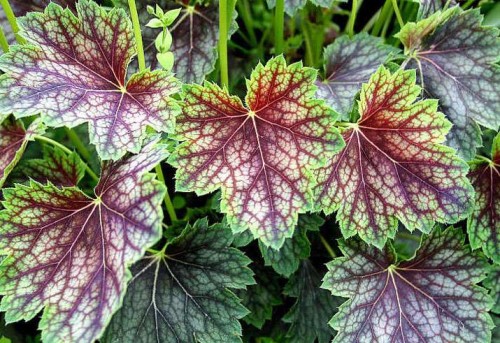
- Geikhera Masproy has large dilated leaves, the diameter of which can reach 20 cm. Cutters and cultural flowers are also covered with vile. Coloring of plants can be different depending on the specific variety.
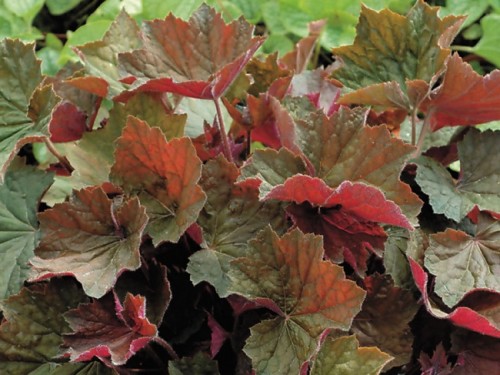
- The leaves of the geihans fine-color in shape resemble maples. Their openwork edges are most pronounced in summer, and by winter, the blades on the foliage almost disappear. The most popular variety of this culture is the Geeher Purple, having a beautiful saturated tinge of leaves. There are species whose foliage has silver splashes. Stems plants are covered with small light beige flowers.
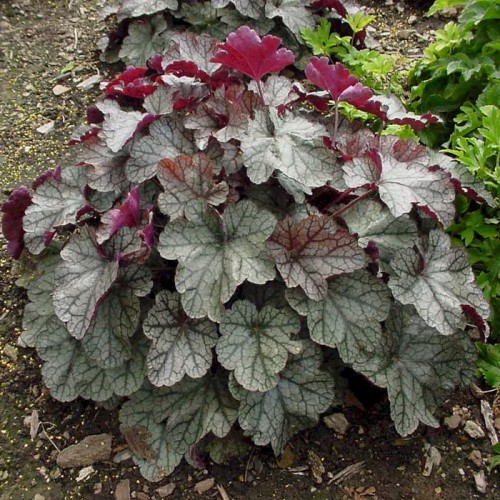
- Gayer cylindrical launches long blossoms that reach height from 60 to 90 cm. Flowers of greenish-white plants, careless. The rosette of the leaves is small, compact, foliage has rounded teeth, painted in a green shade with bright veins. Depending on the variety, the color of leaves and colors may differ.

- Geikhera Red is one of the most spectacular plant species. Culture has quite dense leaves of rich-pink, raspberry or red shades. The foliage has barbed edges and can change the color during the growing season.
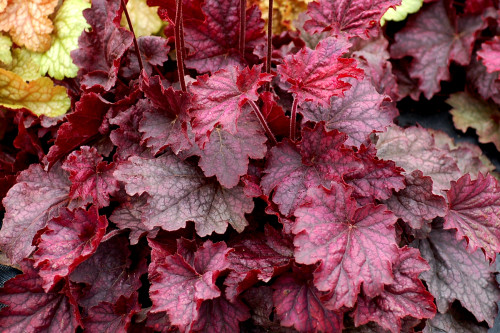
- Geiker Hybrid is similar to the previous grade of culture, but is distinguished by larger leaves and flowers as well as the height of the bloomon. Gaikhera hybrid blooms abundantly and long enough, about 2 months. Inflorescences are painted in white, red or pink shades. The foliage looks very effectively thanks to the beautiful bright rates contrasting the color with a sheet plate.
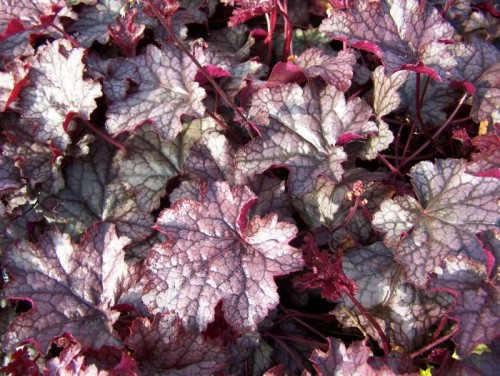
- Gaikhera roaster has small leaves reaching in diameter 7 cm and possess 3 or 5 blades. The height of the bush is about 15 cm, the floweros arrow grows up to 60-65 cm. Flowers are large, painted in white, in diameter reach 5 mm.
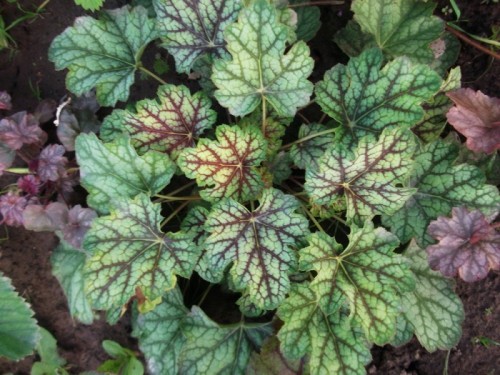
Grinding fineness Geihans
Before growing Geychera, some features of this plant should be known:
- If you are not going to breed a decorative and deciduous culture of seeds, but fighting for the preservation of the picturesque type of geihers, it is better to remove the bloomon at the first appearance. The inflorescences of these species are not too beautiful, but their stalks grow significantly above the outlet of the leaves and spoil the appearance of flower beds.
- As for decorative and flowering varieties, their color pains can be cut off after the boutons are wilting.
- In adult bushes, the lower leaves can turn with time, in connection with which Geikhera loses its decorativeness. In this case, it is necessary to dig a plant before it starts blooming, and then transplant it to another well. We will tell about this method of transplant below.
- Geihans change their appearance during the entire period of development. The youngest foliage seedlings are very tender, translucent, has a bright shade. Over time, the leaves become denser and acquire a darker and rich color.
- In the flower arrangement, this culture can be planted next to an astyleba, primula, a loyal, a ductan or decorative cereal crops.
Geikhera - landing and care
Time and place for planting culture
The first half of the spring is considered to be an ideal time for disembarking this plant in the soil - March and April months. The culture feels perfectly on the shaded areas, so it is best to have a flowerbed from the eastern or western side of the house, under a spreader tree or in another similar place. If there is no sufficiently shaded territory on your household plot, you can plant heikra in the sun and provide her regular abundant watering. It is worth noting that decorative-deciduous varieties under bright solar rays acquire a more attractive shade of leaves. And for geihans with pink and red foliage, it is recommended to pick up a well-lit sunny plot.
Plant Features for Plants
One of the main conditions for growing geihans is correctly selected soil. This culture is perfectly attached in fertile light soil with neutral acidity. The ideal level of pH for geihans is 5-6 units. Increase the alkalicity of the Earth can be made by chalk or wood ash directly before planting plants. The ash, besides, will be a good fertilizer for your colors.
In addition, it is important for growing geihans to ensure good soil drainage. It is impossible to force the caution of water from the roots, because excess moisture provokes the appearance of rot and the plant will die. Make drainage is simple enough: before boarding the geihers, pumped into the dug hole with a small amount of clayjit or brick fragments. In crude weather or with an excess water, the drainage layer will absorb an extra liquid, and during the drought, the roots of the plant will be able to take moisture from drainage.
If you have purchased geihan seedlings in early spring, when it is still early to plant them in the open ground, take the culture into suitable containers and leave for time in the room or in a greenhouse. When the threat of spring frost passes, Geyhera can be transferred to a permanent place in the open soil. In the event that you bought a plant in a pot, while transplanting thoroughly clean the roots from the substrate and cut their tips. If you see that Geikhera has a large number of leaves, but its root system is poorly developed, then remove part of the largest foliage. In this case, the plant is well attached to a new place, and its roots will become stronger. During the landing, immerse the roots in the hole so that there is no empty airspace between them, and the core of the socket has not been risening soil.
Gayhero's care
Proper care for this culture provides for a timely watering with a sufficient amount of fluid. Although Geikhera does not like excess moisture, in dry soil, it also grows not very well. Especially negatively bad watering affects the plant during flowering. Make sure that the land around the bushes was moderately wet. When watering, try to make so that the water has impregnated the soil on sufficient depth. Irrigation is best done twice a day, in the morning and in the evening. In order, the moisture was held in the ground long enough, and the roots did not swap, each autumn mulk the soil around the bushes with foliage, straw or peat.
It is not necessary to feed geyhera fertilizer if it grows with optimal illumination and receives a sufficient amount of moisture. If you decide to add some nutrients into the soil, then do it moderately. Geihans can be filled twice for the season: before the start of flowering and after the inflorescences fell. It is better to use complex compositions with a small content of nitrogen as fertilizers.
The pests of geimers include snails and slugs. These creatures attack the foliage and spoil the young sprouts of culture. The leaves on which the slugs visited are covered with mildew and rot, and after fading and trembling. Advantageously affects the health of plants. Excessive humidity. If water is stood in the soil, the roots are puments, and the plant is dying. In a similar case, you can dig a sick bush, cut healthy branches from it and transplant them as cuttings to the greenhouse.
So that Geichera did not frozen in winter, it is covered with a snack or overwhelming. From above you can additionally pour a layer of snow or cover the bushes Loutrasil. With the arrival of spring, we do not rush to shoot the underfloor material, wait for the whole thawing of the soil. When it is warm enough on the street, enter the geyhera and remove old leaves from it. Pour the roots of a little warm water with mineral fertilizers divorced.
Methods of breeding Geikher.
Growing geihans from seeds
The easiest and easy way to reproduce this culture is seeding. When growing geihans in this way, you get young bushes with a wonderful appearance. But it should be noted that hybrid varieties, as a rule, can lose their varietal features with such reproduction.
You can purchase seeds of culture in a specialized store or from another gardener, but a more reliable and cheap way is to store sowing material yourself. Just keep in mind that the seeds retain a good germination of about 6 months, after half a year, part of the grains may simply not climb. Store the seed material follows in a tightly closed hermetic container.
The seed landing is carried out at the beginning of spring, during the month of March. For sowing it is necessary to choose fertile soil, to carry out its disinfection, then pour into suitable containers, moisturize and explode. On top of the soil, you can also pour a small, thickness of 3-4 mm, a layer of fine sand. After planting seeds to the ground, put the tank in the shaded place and maintain the soil in the wet state. The ambient temperature should be kept at 22-24 ° C. Under such conditions, geims will appear approximately 3 weeks after sowing grains. Slightly grown sprouts need to be divened to separate containers and leave it in the greenhouse until the root system becomes quite strong for transplanting colors in open ground.
Reproduction of the division of the bush
Some geimer varieties require periodic transplant, because over time, their stems are pulled out, the lower leaves fall out, and the barrel is obtained with bare. To return the plants a decorative look, every 2-3 years need to trim and plant them in a new well. Such a rejuvenating trimming occurs as follows:
- After the plant is flashing, you need to cut off the flowers from it and remove the bare parts of the stems. You can deal with the transplant and before the start of flowering.
- Then you should sprinkle sections of saws of wood ash and special compositions that stimulate the root formation.
- The number of leaves should be reduced, and the prepared cuttings can be placed in a greenhouse. Bringing them into the ground, try to place the center of the socket above the surface of the earth. Sand is best suited as soil.
- Do not forget to leave near the stem, a small well, where you will make feeding.
- In the open soil, seedlings are transferred when they root in the greenhouse. But when transplanting on a flower las, it is also important to take into account the calendar dates. If, for example, plants released roots in the fall, then the transplant of them to open ground is better to postpone until spring.
- In the first week after planting plants on the flowerbed, ensure good irrigation to the gamers and do not forget to provide seedlings from direct sunlight. When the culture is captured on the site, the shelter can be removed.
If you do not transplant bushes on time, they may die during the winter months, because the bare stems do not tolerate frosts.
Reproduction Geichera Cherenkovania
When breeding with cuttings, you can take the fragment of the plant with a blooming bush. Spindle geyhera completely no need. At the bottom of the plant, find the branches with the kidneys, cut the shoots and transfer them to a greenhouse or on a well-shaded plot. Treat the sprigs with potassium-containing drugs and put them in the ground so that the kidney is above the ground surface. After about 4-5 weeks, the cuttings should be rooted. Another 1-2 months, the plant can be transferred to the open flower bed.
If the in the fall of the cuttings did not allow the roots, leave them until the next spring, cover with a nestless or other material to protect against winter cold.
Using Geikher in Landscape Design
This culture is valuable in that it can save decorative properties for quite a while. After the rustling of the leaves and before the onset of autumn frosts, the geihers will look great. This plant uses in a variety of flower compositions on the flower beds, in sockets and curbs. Geihans can decorate the shores of water bodies, rocaria or alpine slides. Thanks to the ability to maintain the same form for a long time, Geyhera is often used to create drawings with clear boundaries or strict geometric shapes. This culture is well combined with an astyleba, host, primura, brunter, decorative cereals.

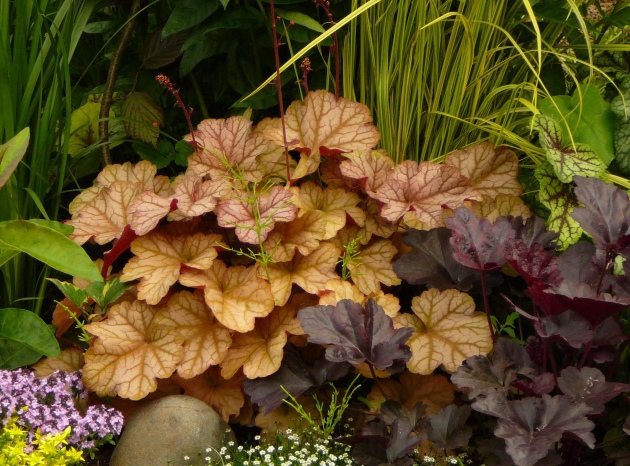

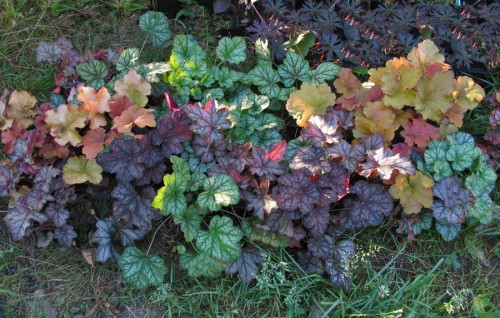

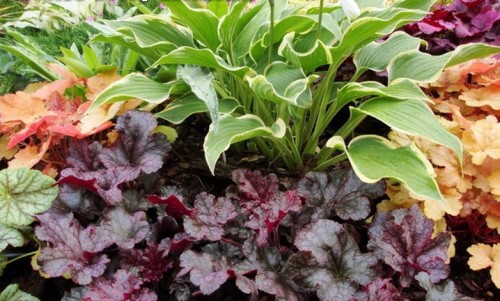
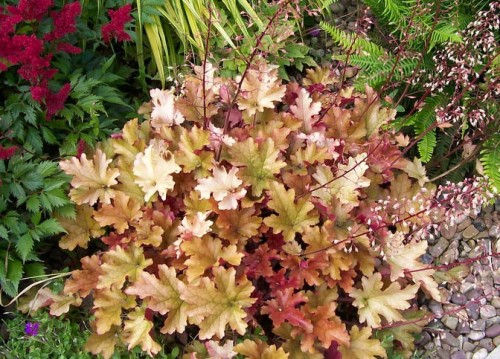
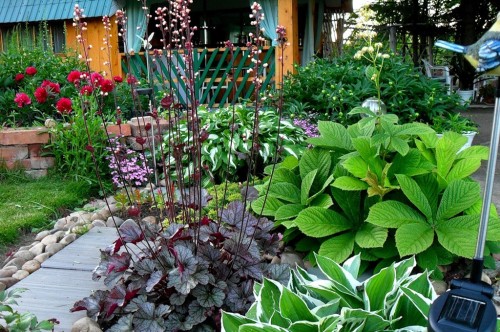

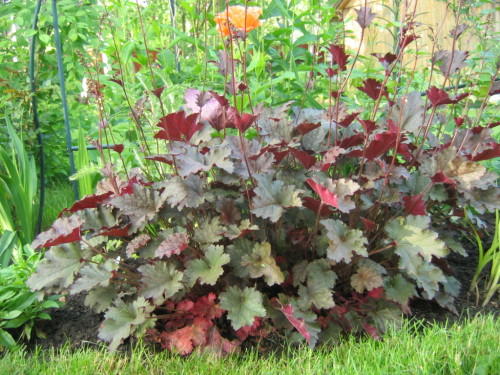












 Start a discussion ...
Start a discussion ...